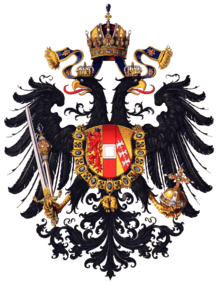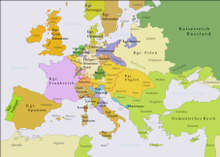German dualism

The term German dualism or Prussian-Austrian dualism refers to Austria and Prussia , which were the two most important powers in Germany from the early modern period until 1866. It denotes both cooperation and rivalry between the two powers.
Austria was traditionally the most important power in the Holy Roman Empire and, after 1815, in the German Confederation . The Austrian ruler had his imperial title initially as Roman-German Emperor , from 1804 as Emperor of Austria directly through the Austrian Empire . Prussia rose to become a kingdom in 1701 with the approval of Austria. The medium-sized state in northeast Germany then built up a strong army and enlarged its territory . In 1740 the young King Frederick II conquered Silesia , which was then Austrian , and thus laid the foundation for enmity. This conflict over the economically important Silesia was partly continued in the Seven Years War (1756–1763).
Despite all the temporary cooperation, Prussia remained the rival that wanted to lead at least on an equal footing with Austria in Germany. The cooperation initially prevented a far-reaching reform of the German Confederation , as the national movement in Germany demanded. During the revolution of 1848, and especially in the autumn crisis of 1850 , the question was whether Austria could even belong to a German nation-state . Austria tried to prevent a small German nation-state under Prussian leadership and made the national movement the offer of a Greater Austria from all over Austria and Germany.
While Austria still prevailed in the autumn crisis of 1850, Prussia was able to strengthen its position in Germany economically and culturally in the next decade and a half. Proposals for federal reform petered out. After Austria and Prussia had ended Danish rule over Schleswig and Holstein together in the German-Danish War , Prussia finally took the administration of these two duchies as an opportunity to seek open conflict in 1866. Contrary to what was agreed with Austria, it occupied Holstein, which was administered by Austria. Austria initiated a federal execution against the troublemaker Prussia, which ended in the German War in July / August 1866.
After Prussia's victory, Austria had to accept the dissolution of the Confederation . Prussia first founded the North German Confederation in 1867 . Austria tried to re-enter Germany. However, during the Franco-Prussian War in 1870/1871 the southern German states joined the North German Confederation. This was renamed the German Empire . From this point in time at the latest, Austria no longer belonged to Germany. In the course of the reorganization of the European alliance system at the Berlin Congress in 1878, the old rivalry with the dual alliance was resolved.
Differences between Austria and Prussia
Country
While the Kingdom of Prussia was more of an artificial state structure, which with the royal coronation of Frederick III. of Brandenburg emerged from the merger of the Electorate of Brandenburg and the Duchy of Prussia , Austria was traditionally the dominant power of the Holy Roman Empire , ruled by the Habsburgs since the 13th century. Prussia, on the other hand, was viewed more as an upstart among the German states, which even more than Austria had no contiguous national territory.
In the 1860s, when industrialization increasingly reached the European continent, Austria, as a great power, did not manage to keep up economically with Great Britain and France and was even overtaken by the neighboring German states (in relation to the share of world industrial production). The level of industrialization in Austria rose less strongly than in the other major European powers (with the exception of Russia). The reasons for this are, on the one hand, Austria's conservative politics ( restoration ) since the Congress of Vienna, and, on the other hand, poor national cohesion and Austria's geography.
military
From a military point of view, the Prussian state was ahead of the Austrian. In Prussia, after the Prussian army reform, there was a modern conscript army , whose officers were promoted according to personal achievements and could also be of bourgeois origin. In Austria, on the other hand, the Habsburg armed forces were dominated by the nobility , who did not fill officer posts based on personal achievement, but often based on seniority.
The structure of the Prussian army was also an advantage: the conscription was three years, while afterwards one belonged to the reserve for four years . So Prussia was able to move in seven years and compensate for the disadvantage that it had fewer inhabitants. In addition, Prussia focused more on quality than quantity; a Prussian private was basically well trained and equipped. In addition, the Prussian General Staff worked on past mistakes and made improvements.
The fact that industrialization found its way into Prussia earlier and more rapidly than in Austria also had a strong influence on the equipment and arming of the armies.
Overall, Prussia was much more militarized than Austria, the influence of the army was so strong that there was a saying that "other states have a military, but in Prussia the military has a state".
State philosophy
Even the faith separated the two countries. The Protestant and enlightened Prussia was to the Catholic and absolutist Austria in opposition . Obedience and self-discipline - voluntary self-commitment - were more important in the civil service and in the Prussian army than faith, which in turn was decisive in Austria. In faraway Konigsberg had Immanuel Kant of reason prevailing over the revelation assigned. The Catholics in Silesia and West Prussia , in Warmia and (until the Kulturkampf ) also in the Rhine Province had it good. The Jews , who had the largest communities in Germany in Berlin , Breslau, and Konigsberg , were no worse off .
In Austria Joseph II ruled according to the principle of enlightened absolutism : “Everything for the people; nothing by the people ”. In contrast to this feudal order of Austria, Prussia was a constitutional state of modern character.
Another essential difference was that Prussia concentrated more on internal German affairs, while Austria expanded to the south and east with the increasing decline of the Ottoman Empire , and crises and conflicts were foreseeable in this new multi-ethnic state ; for between the Germans, Hungarians, Slavs, and many other nationalities - as in the fragmented Germany between the numerous rulers and petty princes - there was often disagreement and divergent interests. In contrast to Prussia, which was able to realize a German nation-state in terms of foreign policy, the Habsburgs were unable to consolidate the multicultural state structure domestically in the age of dominant nationalism.
History 1740–1866
Prehistory of dualism
After Emperor Charles VI. Had died on October 20, 1740 and there was no male descendant in the Habsburg family, Maria Theresa succeeded as ruler of the Habsburg territories in accordance with the Pragmatic Sanction of 1713. But not all European princes recognized the pragmatic sanction, including Frederick II of Prussia. In return for the recognition he demanded Silesia from Austria on the basis of old treaties . On December 11, 1740, he presented Maria Theresa with an ultimatum in this regard.
Silesian Wars 1740–1742 and 1744/1745
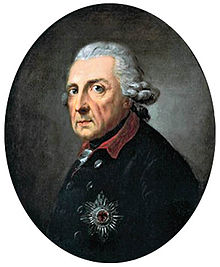
Without waiting for the answer to the ultimatum, Prussia invaded Silesia on December 16, 1740, triggering the First Silesian War and the War of Austrian Succession , as other European powers also laid claim to the Habsburg territories. The Austrians did not succeed in preventing Frederick II from acquiring Silesia. After the lost battle of Chotusitz , Maria Theresa was forced to make peace with Prussia, also in order to end the simultaneous war of succession in favor of Austria. Therefore she concluded the preliminary peace of Breslau and the Peace of Berlin with Friedrich , in which Upper and Lower Silesia and the County of Glatz fell to Prussia; to compensate, Prussia took over the Silesian debts.
After the imperial crown fell to the Bavarian elector Charles VII in 1742 , Austria succeeded in occupying Bavaria and forging an alliance with Great Britain. Therefore Frederick II feared that Austria could demand the return of Silesia from Prussia.
That is why he invaded Bohemia in August 1744 and thus opened the Second Silesian War . Although Prague could be conquered, supply problems and the delaying tactics of the Austrians, who cleverly avoided a decisive battle, forced the Prussian army to retreat to Silesia, which in turn was now threatened. However, since Prussia was able to successfully assert itself on the defensive against Austria and its allies, the Peace of Dresden came about in 1745 , in which the provisions of the Peace of Berlin were once again confirmed. In return, Friedrich II recognized Franz Stephan , Maria Theresa's husband, as Roman-German Emperor after Charles VII died.
From the Silesian to the Seven Years War 1745–1763
After the Peace of Dresden, Prussia was no longer involved in the War of the Austrian Succession, which only ended in 1748 with the Peace of Aachen , in which the European powers recognized the Pragmatic Sanction and Maria Theresa as heir to the throne. Prussia was once again confirmed Silesia in the peace treaty. After 1748 Maria Theresa carried out reforms in her lands, with the exception of Hungary, to improve the state and increase the military strength so that she could regain possession of Silesia. In terms of foreign policy, led by State Chancellor Kaunitz, she tried to isolate Prussia by concluding alliances with Russia and France ( Renversement des alliances ) . After the reforms had taken effect, they prepared the Austrian army for an invasion of Prussia.
After Frederick II learned of the Austro-Russian-French-Saxon alliance through his spies, he was confronted with the problem of a multi-front war. To solve this, he formed an alliance with England ( Westminster Convention ) and invaded Saxony on August 29, 1756 without a declaration of war, which triggered the Seven Years' War . He planned to achieve a quick victory over Saxony and to conquer it because Saxony was important to Prussia for economic and military reasons. After a victory in Saxony, he wanted to quickly conquer Prague in order to permanently station troops in the opposing country. So he wanted to force Austria into peace negotiations, and after a peace agreement Russia should no longer dare to campaign against Prussia alone.
Although he managed to win against Saxony, the Austrians were faster than expected and so his plan to beat Austria quickly failed. He tried again to conquer Prague in 1757, but failed. As a result, the Prussian situation became more and more critical, so that by 1760 Prussia was offensively exhausted and crucial areas (East Prussia, Saxony, Silesia) were in the hands of the enemy; the preservation of Prussia seemed seriously endangered. To Frederick's advantage, however, the disagreement between his opponents, who let their victories over Prussia slip by unused ( miracle of the House of Brandenburg ). The final salvation finally came with the death of Tsarina Elisabeth in 1762, since her successor Peter III. Made peace with Prussia. Then Austria, because it was already at the end of its military and economic strength, was forced to make peace with Prussia as well. In the Treaty of Hubertusburg , Prussia was bindingly assigned to Upper and Lower Silesia including the County of Glatz for all time. From then on, Prussia was the fifth major European power.
From the seven-year-old to the War of the Bavarian Succession 1763–1780
In the Treaty of Hubertusburg, Austria had finally lost Silesia to Prussia. In return, Frederick II had undertaken to vote for the son Maria Theresa Joseph II in the election of the emperor , which also happened in 1764. After that there were no armed conflicts, but Frederick II tried to weaken the emperor, the empire and Austria.
Another situation emerged when Prussia and Russia planned the first partition of Poland . In exchange for Austria's approval, Prussia offered Austria to receive a portion as well. When Austria was partitioned in 1772 Galicia, Russia Polish Livonia and the Belarusian voivodeships and Prussia all Prussian territories that had been under Polish rule until then. Since then, Friedrich II no longer called himself “King in Prussia”, but “King of Prussia”. Even after the partition, the Austro-Prussian tensions did not cease, but there were no armed conflicts.
This changed when the Bavarian line of the Wittelsbach family died out in 1777 and Karl Theodor from the Palatinate line was to inherit the Electorate of Bavaria. But Emperor Joseph II, who saw Bavaria as a suitable place to enlarge his lands after the loss of Silesia and to improve his position in the empire, intervened. Karl Theodor bowed to Austrian pressure and ceded Lower Bavaria and the Upper Palatinate, in exchange for which he was to receive Front Austria . But that met with the rejection of the other members of the Reich and Prussia. Therefore Frederick II had his troops marched into Bohemia, but there was no major battle due to logistical problems. As a result, France and Russia brokered the Peace of Teschen , in which Emperor Joseph II recognized the house contracts of the Wittelsbach family and received the Innviertel from Bavaria.
From the War of the Bavarian Succession to the Coalition Wars of 1780–1812
In spite of the peace, the tensions did not calm down and continued, but without armed conflict. The situation became critical again when Austria planned in 1785 to exchange Bavaria for the Austrian Netherlands (Bavarian-Dutch exchange project). As a result, the Protestant Princes' League was formed against Austria under the leadership of Prussia.
Friedrich II of Prussia died in 1786. At that time, Austria and Russia began another campaign against the Turks to push the weak Ottoman Empire out of Europe and to divide the conquered territories among themselves. But that would have meant a massive shift in power in Europe in favor of Austria and Russia, which the new Prussian King Friedrich Wilhelm II did not want to accept. Therefore, in 1790 he gathered the Prussian army in Silesia to lead it against Austria. But the king himself gave up this plan after a short time because it was too expensive.
Reinforced by the French Revolution in 1789, the new Emperor Leopold II and Friedrich Wilhelm II tried to resolve the Austro-Prussian conflicts on the British initiative , which was also achieved in the Reichenbach Convention of 1790. Austria ended the Turkish War and Prussia its expansion to the east.
In 1791, Austria and Prussia allied themselves in the Pillnitz Declaration and declared their unrestricted solidarity with the French king. The French National Convention then declared war on Austria and Prussia on April 20, 1792 ( First Coalition War ). However, due to outdated army organizations and a lack of willingness to go to war, the two powers did not achieve great victories. Prussia concluded the Peace of Basel in 1795 , Austria the Peace of Campo Formio in 1797 , in which both agreed to the cession of the areas on the left bank of the Rhine to France and had to receive compensation for this.
After the Second War of the Coalition (1799–1801), in which only Austria participated, the Holy Roman Empire as a whole also concluded peace with France ( Peace of Lunéville ), in which it agreed to the cession of all territories left of the Rhine and the affected princes were compensated had to. This happened with the Reichsdeputationshauptschluss of 1803 through mediatization and secularization . The emperor was thus robbed of his most important mainstay of power, so that the dissolution of the Old Kingdom was only a matter of time. At the same time, France proclaimed itself an empire in 1804 . In order to counteract the loss of status and to retain the imperial dignity, Emperor Franz II proclaimed the Austrian Empire on August 11, 1804 . After Napoleon was crowned by Pope Pius VII in December 1804, and thus the special historical position of the Roman (German) emperor as the supreme patron of the Catholic Church was rejected by the latter, and after a renewed defeat in the Third Coalition War in 1805 ( Austerlitz ), in particular but the defection of Bavaria and other southern German states to Napoleon, Franz declared the Holy Roman Empire in 1806 invalid and ended. Austria and Prussia were no longer part of a common political unit.
After that, the two great powers waged wars independently of one another against France, Prussia in 1806/07 ( fourth coalition war ; defeat and loss of great power status) and again Austria in 1809 ( fifth coalition war ; defeat). Both were forced to enter into a military alliance with France (Napoleon) (Prussia in the Peace of Tilsit in 1807 and Austria in the Peace of Schönbrunn in 1809 ), which forced them to march against Russia in 1812.
Wars of Liberation and Congress of Vienna 1813–1815
After the French defeat in Russia, Austria and Prussia broke away from the alliance with France and allied with Russia. Together they liberated Germany from Napoleon. At the Congress of Vienna in 1814/1815, the territories of Austria and Prussia were largely restored to the way they were before 1789. Austria lost in favor of the state unity of Front Austria and the Austrian Netherlands , but received the Kingdom of Lombardy-Venetia , thus shifting its interests even further south.
For Prussia the cession of the territories from the Third Polish Division was a hard loss , it only received Posen and some areas on the Rhine as a protective wall against France, but still had to cede all areas that were not added to the main area because of the state principle of unity, among other things in southern Germany some areas, but received the province of Saxony .
The German Confederation was founded in place of the Old Reich , a defensive alliance of all German states with Austria as the sole presidential power.
From the Congress of Vienna to the Revolution of 1815–1849
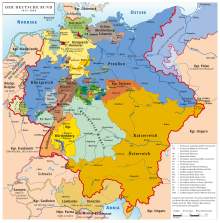
After the Congress of Vienna, a restoration phase began in Germany, which was largely shaped by the Austrian State Chancellor Metternich. At his instigation, liberals and national forces were suppressed, the princes ruled absolutistically, the Karlsbad resolutions were passed in 1819, and a central investigation commission was set up in Mainz to prosecute liberals. This had long-term negative consequences for Austria: the conservative-restorative policy made it socially, politically, militarily and economically behind the European powers. These abuses soon conjured up a revolution.

In March 1848 the abuses mentioned drove the people to the barricades and the revolution broke out. There were many reasons for it: the pursuit of a nation-state, the oppression of the liberals and nationalists, and the social question that arose in the course of the industrial revolution, which was accelerated with the establishment of the German Customs Union in 1834. Barricade fighting broke out in the large German cities, and the princes had to set up liberal governments.
For the first time, an all-German parliament was elected. This Frankfurt National Assembly drew up a constitution for Germany, but this did not come into effect as a result of the counter-revolution. Neither Austria nor Prussia nor the other larger states in Germany wanted a nation state with a liberal constitution. For Austria, a nation-state was a particular problem because of its ethnic fragmentation (only 20 percent of the entire state were Germans). The National Assembly would only have accepted those parts of Austria in the new German Reich that had already belonged to the German Confederation.
While Prussia tried to implement a more conservative small Germany through the Erfurt Union (1849/1850), Austria proposed a Greater Austria : Its entire territory should belong to a German-Austrian confederation . The dispute came to a head in the autumn crisis of 1850 , when Austria and Prussia were on the verge of war. Russian support for Austria led Prussia to abandon its union policy.
Until the end of the German Confederation in 1866
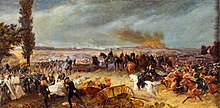
Before 1848 Austria and Prussia had joint leadership in the German Confederation. Although Austria was the presidential power , it consulted Prussia on all important questions. The two great powers began working together again in the same way from 1851. In the ten-year era of reaction , the dualistic leadership again suppressed the liberal and national movement.
At the end of the 1850s, national development slowly got under way again. Prussia tried to use the national movement to expand its power. A federal reform proposed by Austria was rejected by Prussia for fear of losing power; Prussia stayed away from the Frankfurt Fürstentag in 1863. Austria had proposed a simple reform of the confederation.
In 1864 there was another Austro-Prussian cooperation when Denmark, contrary to the provisions of the London Protocol of 1852 , wanted to bind the Duchy of Schleswig closer to the actual kingdom by means of a constitutional amendment. Federal troops with the participation of Austria and Prussia initially occupied Holstein and Lauenburg in a federal execution , a short time later Austria and Prussia finally conquered the Duchy of Schleswig in the German-Danish War. The administration in the duchies was then divided between the two great powers: Austria administered Holstein and Prussia Schleswig.
But disagreements about the administration of the two duchies ultimately led to the German War of 1866, in which Austria was defeated. In the Peace of Prague , Austria had to agree to the dissolution of the German Confederation. Prussia was given the right to reorganize northern Germany. The question of supremacy in Germany was thus resolved, and dualism also came to an end.
literature
- Ulrich Schlie : The duel. The battle between Habsburg and Prussia for Germany . Propylaen Verlag, Berlin 2013, ISBN 978-3-549-07401-5 .

